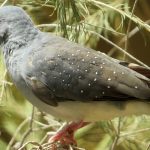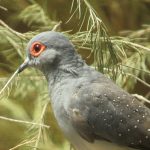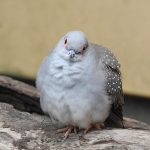DIAMOND DOVE
Diamond doves are one of the smallest dove species, measuring about 18 to 20 cm in length.
They have distinctive plumage with a predominantly light blue-grey coloration on their head, neck, and upper parts. Their wings and tail feathers are adorned with intricate white spots and edges, giving them their “diamond” appearance. They have red-orange eye rings, and their eyes are dark.
Diamond doves are native to Australia and can be found in various parts of the continent, primarily in the northern and central regions. They inhabit a range of environments, including grasslands, open woodlands, and scrublands. In urban areas, they can also be found in gardens and parks.
Diamond doves are generally peaceful and social birds. They often form monogamous pairs and are known for their courtship displays, which involve bowing, cooing, and puffing up their feathers. They are ground-dwelling birds and spend a lot of time foraging for seeds and small insects.
Their diet primarily consists of seeds, especially grass seeds, as well as small insects and grit for digestion. In captivity, they can be fed a mix of small seeds, such as millet, canary seed, and finch mix, along with fresh greens and occasional fruit.
Their breeding behaviour is closely linked to the rhythms of rainfall, making their life cycle both resilient and uniquely adapted to variable climates. Diamond Doves begin breeding at any time after substantial rainfall, ensuring that food and water are available for their young.
This flexible approach allows them to take advantage of favourable conditions whenever they arise, rather than following a fixed season.
The nest is a small and rather delicate platform, constructed from fine twigs or slender grass stems.
It is typically positioned in a low shrub or an open, scrubby tree, nestled among sparse branches for support.
The nest’s fragile design means that, at times, the white eggs can be seen through the thin layer of nest material, giving a glimpse into the doves’ vulnerable beginnings. Both the male and female share the responsibility of incubating the eggs.
The eggs are never left unattended, with the parents taking turns to ensure continuous warmth and protection. This cooperative approach boosts the young doves’ chances of survival in often-challenging environments.
By understanding and appreciating the Diamond Dove’s unique breeding strategies, we gain a deeper respect for how these gentle birds have adapted to Australia’s unpredictable climate. Protecting their habitats ensures not only their survival but also the ongoing vitality of Australia’s diverse birdlife.




